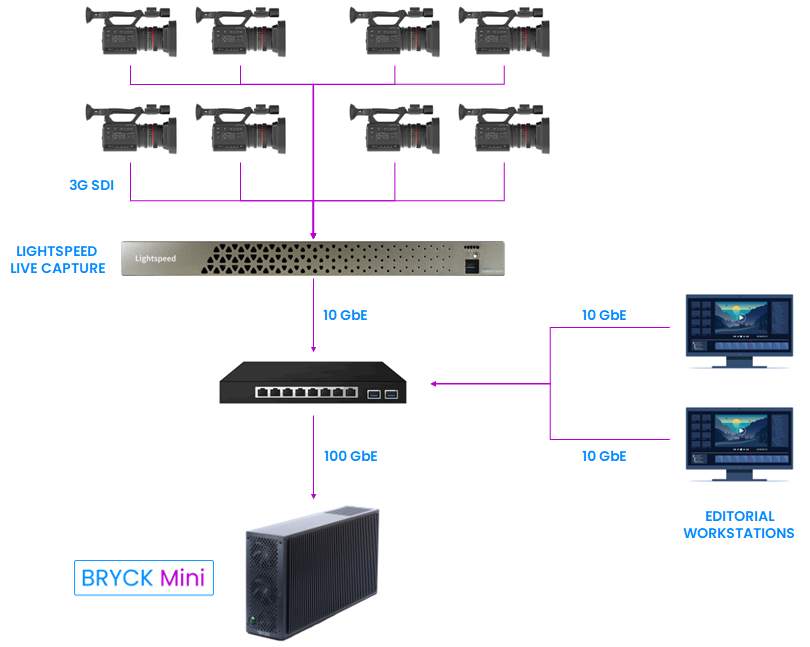In the fast-paced world of live video production, there’s no room for error or delays. Whether it’s capturing a record-breaking touchdown, the electric energy of a superstar performance, or a dramatic reveal in a cooking competition, reliability and performance are fundamental. What’s more, the evolving expectations of audiences require rapid turnaround times for editing, finishing, and distribution workflows to maximize engagement. The integration of the Telestream Lightspeed Live Capture video server with Tsecond’s BRYCK Mini storage device delivers a robust and scalable solution for such demanding multi-camera acquisition scenarios, especially when immediate media transport is critical to downstream processes.
Under the Hood: Live Capture and BRYCK
Telestream’s Lightspeed Live Capture offers advanced real-time capture capabilities for high-resolution video up to UHD/4K, exceptional channel density and robust control mechanisms within a 1RU chassis, making it an optimal solution for demanding field-based video acquisition:
- Up to sixteen concurrent 3G-HD SDI inputs or two concurrent 4K/UHD inputs, facilitating high-density capture.
- Comprehensive codec support, encompassing industry-standard formats such as ProRes, DNxHD, DNxHR, JPEG2000, alongside efficient delivery codecs including x265 and H.264/AVC proxy files.
- Seamless integration with the Telestream Vantage media processing platform for advanced workflow orchestration.
- Flexible control modalities, including continuous 24/7 scheduling, precise RS-422 device control, and a Web Service REST API for programmatic integration.
- Compatibility with leading non-linear editing systems such as Avid Media Composer, Adobe Premiere Pro, and DaVinci Resolve.
Complementing this ease of integration and flexibility, the Tsecond BRYCK Mini provides a feature-filled, portable, ruggedized, high-performance storage solution for bandwidth-intensive workflows in challenging field environments:
- Low power consumption in a compact form factor (3in x 7in x 13.5in, 10lbs.).
- Proprietary self-healing software to ensure data integrity and system resilience.
- Support for high-speed data access protocols, including NFS, SMB, S3, and RDMA, enabling seamless integration into diverse IT environments via two 100GbE ports.
- Encryption key management for enhanced data security.
- An intuitive user interface for real-time performance and capacity monitoring.
The BRYCK Mini streamlines data capture, processing, and analysis at the acquisition point, positioning it as a valuable solution for productions requiring efficient and secure data management in field operations.
Stress Testing the Integration

Diagram of the test system architecture for Tsecond BRYCK and Telestream Lightspeed Live Capture integration
To put these combined systems to the test, industry experts Jillian Arnold from Mission Critical Media and James Delhauer from WinDel Thor Productions replicated the demanding conditions they encounter when managing media capture for major awards and competition shows. The Telestream Lightspeed Live Capture was configured to ingest eight concurrent 1080/60p signals via its 3G-SDI DIN inputs, sourced from cameras, playback devices, and signal generators. The server’s encoding parameters were set to record these streams as DNxHD440 OP1a files with eight embedded audio channels.
Initial testing involved capturing the eight HD streams concurrently to the Lightspeed server’s internal storage, followed by a file transfer operation to the BRYCK Mini. This standard workflow effectively utilized the BRYCK Mini’s high-speed transfer capabilities, fully saturating the 10GigE connection out of the Lightspeed server to transfer the video files faster than real time (approximately 1.25 GB/second).
They then took things a step further, setting the BRYCK Mini as the direct recording destination for the Lightspeed, optimizing workflow efficiency by eliminating the intermediary copy operation. The DNxHD440 files landed straight onto the BRYCK, making them instantly accessible for editing, clipping, and other post-production tasks. The sustained data throughput to the BRYCK Mini ranged from 450 to 650 MB per second, leaving plenty of headroom for background data transfers and concurrent access by multiple workstations. The addition of parallel read and write operations on the BRYCK Mini, including playback of h.265 UHD 59.94p media and rendering of DNxHR HQ UHD 59.94p files from a Blackmagic Resolve system at 120-140fps, did not impact recording performance. As Jillian Arnold noted, “We easily could have added four more capture servers to the system to support a total forty HD 60p streams, and still had bandwidth to support editing and transcoding.”
Test Results Show Efficiency Gains
The tests clearly demonstrate the power of combining Lightspeed Live Capture and Tsecond BRYCK Mini, delivering significant advantages and efficiencies. Direct recording to the BRYCK Mini eliminates the time overhead associated with transferring files from the Lightspeed’s internal storage. This meaningfully accelerates the availability of captured media for downstream workflows through simultaneous access for multiple local artists and operators, streamlining collaboration and eliminating the complexities of data management. Consolidating video file storage on the BRYCK Mini also enables immediate physical transport of the captured media upon completion of the event, simplifying logistics. The Mini’s substantial capacity and high sustained throughput support the simultaneous recording of a high number of streams, accommodating the recording of over 600 hours of HD/60p video. The system also efficiently handles UHD capture, rendering, and processing. Together, Lightspeed Live Capture and BRYCK Mini consistently delivered stable and efficient performance, even under demanding workloads.
The Takeaway: Power and Portability Unite
With Telestream Lightspeed Live Capture and Tsecond BRYCK Mini, video production operations get power and portability: a robust and high-performance solution for video capture and storage that provides consistent reliability even within existing 10GigE infrastructures.
This integrated system delivers exceptional performance, scalability, and flexibility, making it the ideal choice for a wide range of demanding media production environments:
- Live music production and touring
- Sports broadcasting via mobile production units, flypacks, or fixed installations
- Award ceremonies and variety entertainment programs
- Multi-camera unscripted reality television production
- Immersive 360-degree media creation
And while high-value productions have historically necessitated extensive infrastructure, there is an often critical need to minimize operational and technical costs and complexity without compromising technical quality or workflow efficiency. By leveraging the combined capabilities of Tsecond and Telestream technologies, media producers can effectively scale their acquisition systems, accelerate content delivery timelines, optimize their critical capture workflows, and ultimately deliver incredible content to audiences worldwide.
To learn more about the Tsecond BRYCK Mini, visit Tsecond.us.

